|
| |
Contact
Review by Carrie
Gorringe
Posted 11 July 1997
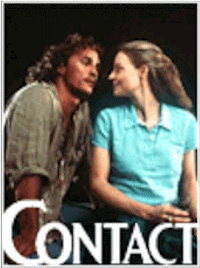 |
|
Directed by Robert Zemeckis
Starring Jodie Foster, Matthew
McConaughey,
James Woods, Tom Skerritt, Angela Bassett,
John Hurt, David Morse, William Fichtner,
and Rob Lowe
Screenplay by James V. Hart
and Michael Goldenberg,
based upon the novel by Carl Sagan |
On the issue of extraterrestrial
exploration, I have to admit that the subject leaves me, not with a sense of indifference,
but rather with a sense of extreme bemusement. While news reports proclaim, almost
breathlessly, that over 100 million people have visited the Mars Pathfinder website
established by the National Aeronautics and Space Administration, there is a temptation to
ask just what it is about space walks by lunar modules that inspires the sort of adulation
usually reserved for more earth-bound stars. Is it mere human wanderlust? The promise of
greater scientific discoveries? A metaphorical throwback to the great space exploration of
the 1960s, when such explorations were equated with American military and economic power?
An attempt to avoid more intractable social problems by concentrating upon scientific
problems that, in their empirical realm, appear to be more amenable to a solution, however
eventual the progress? The last two questions don’t necessarily have to be fuelled by
anti-government suspicion to render them legitimate points of inquiry, but anyone
attempting to analyze what can almost be referred to as an obsession with exploring the
great galactic beyond might do well to include them as part of his or her inquisitive
repertoire.
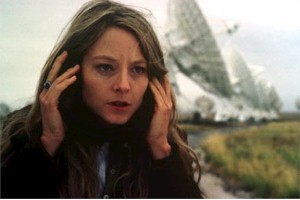 One might have
expected this sort of questioning from America’s premier, or at least most notable,
astronomer, the late Carl Sagan, but, after reading Sagan’s 1985 bestseller, Contact,
I was inspired to ask three questions: is there intelligent life out in the great
intergalactic beyond, is Mars really that cold, and what, in the name of Venus, was this
book doing on the fictional bestseller list? It may be heresy to describe Sagan, who went
to the great observatory in the sky last December after a long illness, as no writer of
fiction, however redoubtable his gifts as a masterful synthesizer of science for the
uninitiated (as his book, Cosmos, made quite evident); Sagan’s strikingly
original vision of searching for extraterrestrial life, however, was marred by
considerable forays into the mire of hokey melodrama and a dubious gift for the cultural
tautology which was utterly stunning for a Ph.D. On the latter front I offer up as
evidence one early chapter, concerning the heroine’s upbringing, that includes
several paragraphs relating, with all of the earnestness of an acolyte, the discovery of
contradictory and – yes! – even hypocritical passages in the Bible; this is a
declaration somewhat akin to the observation that the air on Earth contains oxygen. To
call some of the prose and concepts in Contact leaden is to miss the sound of
hearing the more insufferable parts already crashing through successive floors on their
way to a resounding boom at their final destination. Sagan’s intent, no doubt, was to
fuse popular narrative with scientific information, to become something of a scientific
John Steinbeck for the 1980s; instead, he came across as being more like astronomy’s
answer to Judith Krantz. Contact would have been a mere blip on the bestselling
radar screen had it not been for Sagan’s towering reputation. One might have
expected this sort of questioning from America’s premier, or at least most notable,
astronomer, the late Carl Sagan, but, after reading Sagan’s 1985 bestseller, Contact,
I was inspired to ask three questions: is there intelligent life out in the great
intergalactic beyond, is Mars really that cold, and what, in the name of Venus, was this
book doing on the fictional bestseller list? It may be heresy to describe Sagan, who went
to the great observatory in the sky last December after a long illness, as no writer of
fiction, however redoubtable his gifts as a masterful synthesizer of science for the
uninitiated (as his book, Cosmos, made quite evident); Sagan’s strikingly
original vision of searching for extraterrestrial life, however, was marred by
considerable forays into the mire of hokey melodrama and a dubious gift for the cultural
tautology which was utterly stunning for a Ph.D. On the latter front I offer up as
evidence one early chapter, concerning the heroine’s upbringing, that includes
several paragraphs relating, with all of the earnestness of an acolyte, the discovery of
contradictory and – yes! – even hypocritical passages in the Bible; this is a
declaration somewhat akin to the observation that the air on Earth contains oxygen. To
call some of the prose and concepts in Contact leaden is to miss the sound of
hearing the more insufferable parts already crashing through successive floors on their
way to a resounding boom at their final destination. Sagan’s intent, no doubt, was to
fuse popular narrative with scientific information, to become something of a scientific
John Steinbeck for the 1980s; instead, he came across as being more like astronomy’s
answer to Judith Krantz. Contact would have been a mere blip on the bestselling
radar screen had it not been for Sagan’s towering reputation.
Sagan’s book was replete with agnostic undertones which often flared into an
anti-religious diatribe. While Sagan’s comments on the dangerous and irrational
behavior of that oxymoron known as the religious right are not without considerable merit,
the strident and unthinking satire to which Sagan’s book subjects this religious
subsection tends toward an implication that faith and scientific progress are somehow
mutually exclusive (Sagan seemed to be immune to the realization of how much his
heroine’s intergalactic quest bears a remarkable resemblance to the patterns of a
religious crusade, especially in regard to the aesthetic and fanatical devotion to her
mission and her desperate need to persuade others of the rectitude of her goal); the two
worlds need not exist in antagonistic tandem, or perhaps Sagan realized the affinities
between them too late and hoped that readers would not make that most uncomfortable of
associations.
Stripped of all its superfluous elements, Contact involves its audience in the
life of an astronomer, Ellie Arroway (Foster), who, since childhood, has been obsessed
with finding other life out beyond the earth, a search encouraged by her late father
(Morse), who died when Ellie was ten. Ever since, this dual-pronged obsession –
scientific research coupled with a barely-latent desire to communicate once again with her
father – has driven her life. When the government, under the auspices of her old
rival, David Drumlin (Skerritt) takes away her funding, she enlists the help of
billionaire S. R. Hadden (Hurt), whose eccentric and secretive demeanor reveals him to be
the result of a failed attempt to combine the DNA of Howard Hughes and Bill Gates, to fund
her research. One night, in the New Mexico desert, Ellie gets the call to
compliment her calling, and brings herself right into conflict with the U.S. Government,
which reasons that, since Ellie’s organization rents telescope time from it, the
discovery can be commandeered under the guise of national security concerns. 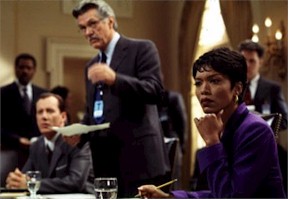 She then must work
against not only Drumlin, but also National Security Adviser Michael Kitz (Woods), a
creepy paranoiac who seems happy to have found a new replacement for his old Cold War
scapegoats and Rachel Constantine (Bassett), a presidential adviser of high rank who
doesn’t really share Ellie’s apparently manic sympathies. Ellie must also fight
against Richard Rank (Lowe, in a brilliantly sly performance and inspired bit of casting),
a whacko fundamentalist leader who sees something ungodly in her ambitions. Ellie does,
however, have two people in her corner: Dr. Kent Clarke (Fichtner), Ellie’s longtime
supporter and co-star-gazer, and Palmer Joss (McConaughey), her former lover, now an
influential author who acts as a bridge between Ellie and the extremists of all stripes
surrounding her. As progress is made on the message sent by the alien powers and it is
discovered that it contains blueprints for a transport device, all participants gear up
for the fight to see who will be the first to use it. The fighting for position and for
self-discovery has the potential for scientific and personal advancement, as well as
tragedy, on a grand scale. She then must work
against not only Drumlin, but also National Security Adviser Michael Kitz (Woods), a
creepy paranoiac who seems happy to have found a new replacement for his old Cold War
scapegoats and Rachel Constantine (Bassett), a presidential adviser of high rank who
doesn’t really share Ellie’s apparently manic sympathies. Ellie must also fight
against Richard Rank (Lowe, in a brilliantly sly performance and inspired bit of casting),
a whacko fundamentalist leader who sees something ungodly in her ambitions. Ellie does,
however, have two people in her corner: Dr. Kent Clarke (Fichtner), Ellie’s longtime
supporter and co-star-gazer, and Palmer Joss (McConaughey), her former lover, now an
influential author who acts as a bridge between Ellie and the extremists of all stripes
surrounding her. As progress is made on the message sent by the alien powers and it is
discovered that it contains blueprints for a transport device, all participants gear up
for the fight to see who will be the first to use it. The fighting for position and for
self-discovery has the potential for scientific and personal advancement, as well as
tragedy, on a grand scale.
Admittedly, there were some promising elements of note in Sagan’s novel, most
notably Sagan’s long speculative dissertations on what extraterrestrial life might be
like and how we might go about the messy business of finding and communicating with it.
These aspects of the novel – the very best parts that displayed Sagan’s enormous
intellectual and imaginative talents to their fullest – might have been transformed
into a fascinating film, with the formulaic plot and characters serving as interesting
vehicles for the transmission of said ideas into mainstream entertainment. Unfortunately,
the task of so doing was handed to Robert Zemeckis, a director with a penchant and a
genuine gift for fantasy (Who Framed Roger Rabbit? and the Back to the Future
series), but one whose grasp of history tends, at best, to be informed by the same sort of
fantastic mindset (the best example of this is his last film, Forrest Gump, that
Oscar-winning piece of cynical, feel-good sludge, in which he managed to persuade a great
number of baby-boomers of their essential goodness and naivete during the 1960s; they had
done nothing to precipitate social upheaval; it had just happened to them, just like it
had to the mentally-challenged and good-natured Forrest). Given the limits of his
directing parameters, it isn’t at all surprising that Zemeckis was having
difficulties with adapting Contact for the big screen, a problem he alluded to in
an interview. As Zemeckis saw it, Contact "spans years and countries, vast
distances with hundreds of characters" and "the biggest challenge to me was to
condense all of that [material] into a clear and compelling story." Clear the film
may indeed be, but compelling it is not, as the film succeeds in achieving only half of
Zemeckis’ stated goal.
To their credit, Zemeckis and screenwriters Hart and Goldenberg do succeed in
fashioning a clear-cut narrative from all of Sagan’s flashbacks, but their idea of
streamlining has more to do with thoughtless clear-cutting than with a skillful paring
away of material. Valuable background material from the novel, especially that pertaining
to the development of the antagonism between Ellie and Drumlin,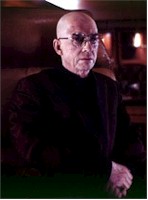 is given a perfunctory
heave-ho; with it went any hope of understanding the depths of their mutual distrust. What
little that remains of Sagan’s original vision is purely coincidental and has a
deleterious effect upon the characters who have to carry their one-dimensional
psychological profiles into an equally truncated plot. Ellie Arroway becomes nothing more
than earnestness personified: any inner conflict her character might possess has been
boiled down to its essentials and reboiled again for bad measure; the subtle complexities
of Ellie’s ambition have been drowned in the old love-versus-career chestnut as she
fights that old feeling between her and Palmer. Other characters suffer the same
undermining of structure; Drumlin is reduced to nothing more than an academic Sammy Glick,
all scheming ambition and limply sarcastic comments (in the first encounter between
Arroway and Drumlin, he asks her, sotto voce, if E.T. has phoned home yet). Kitz
spouts a paranoiac stream-of-consciousness babble appropriate to a Cold War bureaucrat, or
someone who has seen It Came From Mars one too many times. Only Hurt’s whacky
and sardonic rendition of Hadden manages to stand out among the other dimmed stars. is given a perfunctory
heave-ho; with it went any hope of understanding the depths of their mutual distrust. What
little that remains of Sagan’s original vision is purely coincidental and has a
deleterious effect upon the characters who have to carry their one-dimensional
psychological profiles into an equally truncated plot. Ellie Arroway becomes nothing more
than earnestness personified: any inner conflict her character might possess has been
boiled down to its essentials and reboiled again for bad measure; the subtle complexities
of Ellie’s ambition have been drowned in the old love-versus-career chestnut as she
fights that old feeling between her and Palmer. Other characters suffer the same
undermining of structure; Drumlin is reduced to nothing more than an academic Sammy Glick,
all scheming ambition and limply sarcastic comments (in the first encounter between
Arroway and Drumlin, he asks her, sotto voce, if E.T. has phoned home yet). Kitz
spouts a paranoiac stream-of-consciousness babble appropriate to a Cold War bureaucrat, or
someone who has seen It Came From Mars one too many times. Only Hurt’s whacky
and sardonic rendition of Hadden manages to stand out among the other dimmed stars.
Zemeckis may have robbed us of characterization, but he tries to make up for his sins
of omission by substituting lots of cinematic razzle-dazzle. He brings back the
computer-improved footage from Gump for one more go-around, and, as before, uses it
just as unconvincingly. 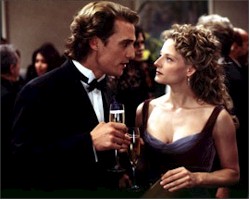 We aren’t treated to Forrest’s confession to the ruler of the free
world of the need to avail himself of the White House’s facilities, but we are
allowed to have President Billy providing his "analysis" of the alien missive,
not to mention the contributions of what seems like everyone from CNN (Bernard Shaw and
Wolf Blitzer throw in their two cents’ worth, for what it’s worth). This
sleight-of-multiple screens is supposed to convey an air of legitimacy, and accuracy to
the enterprise under, as it was supposed to in Gump, but rather just serves to jar
the viewer out of the illusion. In their desperation to keep the film’s bloated
narrative flowing (the film’s running time is over two hours and twenty minutes and
it seems at once to be too long and incomplete at that length), screenwriters Hart and
Goldenberg not only manage to make the film seem even more formulaic than the novel, but
they also seize upon news footage as a way to get all of the information to the audience;
in the process, they interrupt the film’s flow, and detract from a story that
contained more than enough interest without their vain attempts to tart it up (most
notably in the opening quasi-credit sequence, which moves with the speed and knowing
intent of Mae West descending a staircase to a crowd of admirers, and elicits more than a
few guffaws in the audience for its laughably languorous efforts). The entire enterprise
reminds us of a line first uttered by Ellie’s father (and, in true Irving Thalberg
tradition, repeated twice more over the course of the film), "If it is just us [out
there], it seems like an awful waste of space." We aren’t treated to Forrest’s confession to the ruler of the free
world of the need to avail himself of the White House’s facilities, but we are
allowed to have President Billy providing his "analysis" of the alien missive,
not to mention the contributions of what seems like everyone from CNN (Bernard Shaw and
Wolf Blitzer throw in their two cents’ worth, for what it’s worth). This
sleight-of-multiple screens is supposed to convey an air of legitimacy, and accuracy to
the enterprise under, as it was supposed to in Gump, but rather just serves to jar
the viewer out of the illusion. In their desperation to keep the film’s bloated
narrative flowing (the film’s running time is over two hours and twenty minutes and
it seems at once to be too long and incomplete at that length), screenwriters Hart and
Goldenberg not only manage to make the film seem even more formulaic than the novel, but
they also seize upon news footage as a way to get all of the information to the audience;
in the process, they interrupt the film’s flow, and detract from a story that
contained more than enough interest without their vain attempts to tart it up (most
notably in the opening quasi-credit sequence, which moves with the speed and knowing
intent of Mae West descending a staircase to a crowd of admirers, and elicits more than a
few guffaws in the audience for its laughably languorous efforts). The entire enterprise
reminds us of a line first uttered by Ellie’s father (and, in true Irving Thalberg
tradition, repeated twice more over the course of the film), "If it is just us [out
there], it seems like an awful waste of space."
Contents | Features
| Reviews | News | Archives | Store
Copyright © 1999 by Nitrate Productions, Inc. All Rights
Reserved.
| |
|